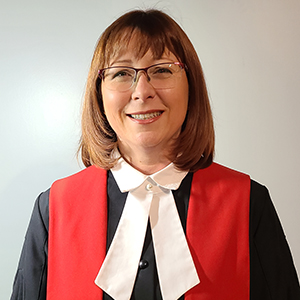 What was your path into law and onto the bench?
What was your path into law and onto the bench?
My family is from Abitibi. My mother’s side of the family were among the first people to settle in Amos. I have strong ties to the region, and I’ve lived there since I was a young child. I attended school in the region up through Cégep—I had a fairly straightforward path. Initially, I studied science in college. I was hoping to become an actuary, as I had a keen interest in mathematics. But my first year at Cégep was a big turning point for me. I realized that actuaries don’t work with people very much, and that wasn’t a good match for my personality. I decided to change things up at school, transferring to a humanities program, though I stayed enrolled in my math courses. At the time, I thought business administration looked like a good option for me.
In addition to my studies, since the age of 16, I had been working summers at a law firm, where my uncle was a partner. Little by little, I began to get the hang of the different aspects of the profession—dealing with people, providing support, and doing legal research, to name just a few.
When it came time to apply for university, I was torn between business administration and law, so I applied to both. Ultimately, I went into law at Université de Montréal—my immersion in the legal profession during my summer job convinced me that I would be best suited to being a lawyer.
I was admitted to the bar in 1994 and returned to the area where I’d grown up. I was lucky enough to have an articling opportunity waiting for me at that same law firm, at a time when the race to secure an articling position was intense and fairly gruelling for many graduates.
I worked as a lawyer for ten years, practicing in various specialties of civil law, primarily family and municipal law. One of the partners was a specialist in municipal law and passed his passion on to me.
Although they’re quite different, the two fields of law struck a good balance. One helped me deal with clients’ emotions, while the other was more logic-based, with work that was essentially preventive in nature. Municipal law also gave me a chance to organize training sessions for elected officials and city managers. The teaching aspect was of particular interest to me, as it brought me a new way to interact with people.
I went on to join another law firm that was opening a new office in Amos, where I practiced until my appointment to the bench.
I had been hesitant about putting myself forward for the bench for a long time, as I was significantly involved with my community and concerned about the age of my children. But over the years, after I’d learned more about the role from different justices, and my children grew more independent, I felt ready to take on the challenge and put my name forward. However, since I’d never been willing to leave Amos, opportunities on the Superior Court were few and far between—there’s just one position in Amos.
The judge in that role was transferred to another city in May 2017, and I updated my application. I was appointed to the Superior Court in November 2017, at the age of 46.
What experience in your legal career best prepared you for work on the bench?
I’d say everything I’ve done has prepared me for this work. One example was my municipal law practice, where I spent time drafting a lot of documents, such as regulations and complex legal opinions. The types of professional development courses I gave were also an asset, as your job in a courtroom often involves teaching people, especially litigants who are self-represented themselves.
Of great use to me as well was the fact that I’d argued cases in court before. This helped me master concepts like the burden of proof and procedural rules.
Practicing family law taught me how to deal with people’s emotions, not to mention marriage tax law. It also helped me hone valuable skills in the field, including my mediation training, which was extremely useful to me in courtrooms and in holding settlement conferences.
I have always valued attention to detail. It was also a central value at both of the law firms where I practiced. This prepared me for being a judge as well, as you have to be incredibly thorough.
What advice do you have for counsel who appear before you?
Prepare, prepare, prepare! Master your case theory. I usually start my hearings, especially for civil litigation, by telling counsel on both sides, "Give me your case theory in three minutes." That’s when you can often see who’s ready and who isn't. Good preparation helps you submit more relevant evidence, instead of taking a scattershot approach, or what I’d call a "Chinese buffet" style.
Remember that sometimes, the best cross-examinations aren’t about asking questions. That’s some advice I got from a training I took many years ago, and it remains useful to this day. Case theory helps you organize your evidence and decide whether you really need to cross-examine someone.
Be respectful, not just to the court, but to the other parties, and your colleagues, even when you disagree. When things go before a judge, obviously it’s because there’s a dispute involved. But if we respect one another, then the trial goes a lot smoother. This can help you with admissions and reaching agreements, even partial ones. If you’re constantly at each other’s throats and disrespecting one another, it just undermines your own case.
When I was a lawyer, I often reminded young lawyers that counsel's role is to help clients find a solution to their problem. That solution isn’t always found in court.
What do you wish the public knew about the justice system?
A judge has a role that goes well beyond what the public might think about a case, especially when they’ve seen it glossed over in the media and online. Judges have to make a ruling based on the evidence they’ve seen and applicable legal rules. Our job is to apply the rule of law. We are guardians of this vital aspect of our democracy. If we had to base our decisions on fairness or public opinion, instead of the rule of law, things would get very arbitrary very quickly.
Like society, the bench looks a lot different than it used to. Forty years ago, there were very few women in the workplace, there was less immigration, and society was more homogenous. The same was true of the bench, which was mostly made up of grey-haired old men. Today, society is more diverse, and the bench has reflected these changes. It’s not uncommon now to see judges appointed in their forties, sometimes even earlier. There are more women and people from diverse communities and cultures.
This diversity makes it easier for the legal system to understand everyone’s different situations, be more sensitive to modern issues, and keep an open mind. This aspect of law is something that deserves more attention.









